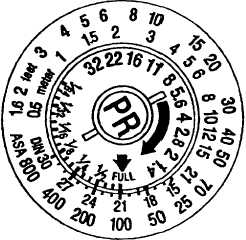Figure 5-26.–Manual exposure scale.
When the flash unit is in the manual mode, the f/stop
must be changed each time the flash-to-subject distance
changes. A scale on the flash unit indicates the proper
f/stop to use for the various distances. To determine the
flash-to-subject distance for on-camera flash, focus on
the subject and read the distance directly from the
focusing ring on the camera. Figure 5-26 indicates with
IS0 100 film at full power the proper aperture setting at
10 feet is between f/11 and f/16.4 feet is f/32, 40 feet is
f/2.8, and so forth.
SINGLE FLASH
The majority of your indoor photographs will be
produced using a single-flash unit. Numerous
reenlistments, frockings, and promotion ceremonies are
conducted indoors where the lighting conditions are
unfavorable for available light photography. There are
various methods in which a single flash can be used to
produce high-quality professional photographs that
distinguish you, the Photographer's Mate, from the
amateur snapshooter.
On Camera Flash
A commonly used flash technique is to have the
flash unit attached to the camera in synchronization with
the shutter and aimed directly at a subject. An advantage
of having your flash unit attached to the camera is it
provides you the chance to capture the unexpected-the
truly candid shot. When spontaneity sparks the action
and quick-camera handling is a must, the fewer pieces
of equipment you have to worry about or handle the
better. Rather than two pieces of gear-the camera and
the flash-you have only one-the camera with the flash
attached to it; however, this technique usually produces
objectionable shadows behind the subject.
To help reduce the harshness of the shadows
produced behind your subject when a single flash is used
at the camera, place some diffusion material, such as a
white handkerchief, cheesecloth, or frosted cellulose
acetate, in front of the flash. Of course, diffusion reduces
the intensity of the light, and the exposure has to be
increased accordingly when using the manual mode on
the flash unit.
Most imaging facilities are equipped with flash
brackets. When you are using a flash bracket, it is
possible to rotate the flash when changing formats from
horizontal to vertical. When shooting people in the
vertical format using a flash unit, always position the
flash above the lens. If the flash is below the lens, long
objectional shadows are cast behind the subject, and the
subject has an unnatural, eerie, sinister effect.
Red Eye
A result that may appear with direct flash is
“red eye.” Red eye occurs in pictures of people
and animals when the flash is used close to the
optical axis of the lens and the subject is looking
at the camera. Light reflecting from the blood
vessels at the back of the eye causes this effect.
The darker the room is, the stronger the effect,
because the pupils of the eyes become more
dilated. Red eye can easily be avoided by
moving the flash away from the lens optical
axis. Also, the effects of red eye can be
minimized by turning up the room lights.
Bounce Flash
One of the better methods to illuminate a subject or
scene with a single-flash unit is to use bounce flash.
There are times when you want a very soft light in order
to lessen the tonal range between highlights and
shadows and to soften harsh background shadows. You
can achieve this soft lighting by bouncing, or reflecting,
the flash off a light-colored surface. By doing so, you
are changing the narrow spot of light from a flash unit
into a wide diffused area of light. When shooting color
film, avoid colored walls and ceilings. They reflect their
color onto the subject, causing a color cast over the
entire subject area. You should use bounce flash in all
5-32


